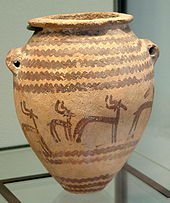Before the beginning of the pre-family era, the arid Egyptian climate was less arid than it is today. The savannah grass covered large areas of Egypt and was passed by herds of shepherds. Livestock and vegetation were more abundant now than in all regions, and the Nile River region helped to breed groups of waterbirds. Hunting was common among Egyptians at that time, many of which were also domesticated.
In about 5000 BC, small tribes lived in the Nile Valley and developed a series of cultures that were dominated by agriculture and animal husbandry, as well as artifacts from pottery and private property found. The largest of these civilizations was the Badari civilization in Upper Egypt, which was famous for its high quality ceramics, stone tools, and copper use.
In the north, al-Badari followed the Amaratian and Georgian civilizations, which showed a number of technological developments. During the Khirazian period, early evidence proved a connection with Canaan and the coast of Byblos
In the south, the Naqada civilization highlighted the Badari civilization and began to expand along the Nile by about 4000 BC. Early in the Naqada civilization, the ancient Egyptians imported incense from Ethiopia, which was used to transport feathers in addition to other things.
Photos from the era of pre-dynastic.jpg)
.jpg)
Free images from Wikipedia
Over a period of about 1,000 years, the Naqada civilization evolved from small agricultural communities into a strong civilization whose leaders had full control over people and resources in the Nile Valley. The leaders of Naqada sought to extend their control of Egypt north along the Nile by establishing power centers in Herakonpolis and then in Abydos.
They traded with Nubia in the south, Western desert oases in the west, and Eastern Mediterranean cultures in the east
The people of al-Naqada made a variety of precious goods, reflecting the increase of energy and wealth in the elite class, which included pottery painting, high-quality stone vases, art paintings and jewelry made of gold, and ivory. They also developed the glaze ceramics known as Qishani, which was used in Roman times to decorate cups, amulets and statues. Before the end of the pre-family era, the people of Naqada began to use scriptural symbols that would eventually develop into a complete system of hieroglyphics to write the ancient Egyptian language.
.jpg)

Free images from Wikipedia
Thanks for the follow-up and readers and posting.
Very nice article you have there! But do not forget to cite your sources and credit your images when necessary
OK I will,
thank you so much.
Hello, please follow the rules of the group Steemit for Resteem ↕ and you will be resteemed by the most active members in the group.
You have to resteem a post from the group before you post yours there.
Here is : HOW TO RESTEEM ON STEEMIT ?